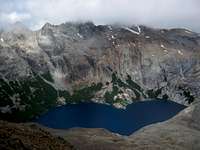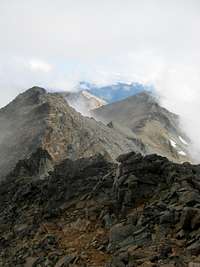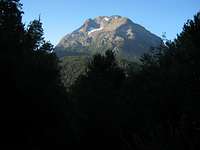-
 17002 Hits
17002 Hits
-
 77.12% Score
77.12% Score
-
 8 Votes
8 Votes
|
|
Mountain/Rock |
|---|---|
|
|
41.20847°S / 71.66497°W |
|
|
Hiking, Mountaineering, Scrambling |
|
|
Spring, Summer, Fall |
|
|
7405 ft / 2257 m |
|
|
Overview
First off, let's clarify which Cerro Bonete we're talking about, as there are at least four Cerro Bonetes in Argentina. Cerro Bonete (Mendoza), a 5004m peak in the Aconcagua Group, is a popular acclimatization hike before climbing Aconcagua. Cerro Bonete Chico (La Rioja) is located in the Puna de Atacama near Mount Pissis. At 6759m, it is the 4th highest peak in the Andes. Finally, Cerro Bonete Grande (La Rioja), also located in the Puna de Atacama, is an obscure 5935m peak near the Caldera del Inca.This page is about Cerro Bonete (Rio Negro) which is the 3rd highest peak in Parque Nacional Nahuel Huapi (after Cerro Tronador and the Cerro Catedral Massif). Located in the heart of the park, towering above Lago Azul and Lago Creton, Cerro Bonete is remote, rugged, and stunning. It features a complex summit and is one of the only glaciated peaks in the park. The climb is not terribly difficult, but it does involve a significant approach, challenging route-finding, and some difficult scrambling. Plus, it is located in a portion of the park that receives fairly few visitors, so you may well have the place all to yourself.
The current normal route seems to be from Laguna Azul, climbing mostly through scree and talus on the western slopes of the mountain. I have not yet climbed up from this side, but I have reason to believe that this is both the most popular and the least technical route to the summit. I climbed Bonete via the north ridge from the pass between Laguna Creton and Mallín Mate Dulce. This involved a challenging 2.5km traverse that scrambled over or bypassed numerous false summits. Finally, John Biggar refers to a route up the south face in his book The Andes: A Guide for Climbers. I have been unable to confirm anything about this route. Via any of these routes, climbing Cerro Bonete is a long challenging hike with some potentially difficult scrambling.
In theory, Bonete could be climbed in a day from the Los Cesares trailhead, but it would be a big day and would be quite complicated without having private transportation and/or spending a night near the trailhead. Most people will choose to camp at Laguna Azul and climb from there. It's well worth it, as this lake is one of the hidden gems of the park. Note that while the lake is commonly referred to as Laguna Azul, it is listed as Laguna Callvu on most maps. Callvu is the local native Mapuche's word for Azul, which of course is Spanish for Blue. If you have spare time at Laguna Azul, you can explore Laguna Jujuy and/or Laguna Creton or attempt to climb Cerro Punta Negra. There are also options of continuing your trek on to Laguna Ilon and Pampa Linda near Cerro Tronador or, alternatively, towards Laguna CAB and Laguna Negra and/or Cerro Lopez near Colonia Suiza.
When you get up on the summit ridge, you may also be treated to excellent views of the lakes and other peaks in the area including Cerro Tronador. Unfortunately, when I was there, there were mostly clouds, and even seeing the peak I was on was challenging. Incredibly, just when I reached the summit, the clouds parted momentarily to offer me a glimpse of Tronador. Note that the presumed summit of Cerro Bonete is marked by a cross and a small summit register. However, there are two nearby spires that seem to be at roughly the same elevation as the summit cross. Climbing either of these would appear to present a considerable challenge. In the foggy conditions I encountered up there, it was difficult to verify if one of these spires might actually have been the true summit.
Approach
The quickest, most direct access to Cerro Bonete is from the Los Cesares Trailhead via Laguna Azul. From Bariloche, there is one bus daily for Pampa Linda, at the base of Cerro Tronador. The bus leaves at 8:30 from in front of the Club Andino. Ask to be let off at Los Cesares, roughly a half hour before Pampa Linda. From Bariloche to Los Cesares usually takes about 2 hours. The return bus passes by Los Cesares around 17:30. As of February 2013, the roundtrip fare to Pampa Linda is $AR 160 and one-way is $AR 100. To Los Cesares, I paid $AR 70 one-way. Note that this touristic bus is only available during the summer season.
From Los Cesares, follow the trail for twenty minutes until you arrive at a large undeveloped campground by the Rio Manso. Cross the river on a hanging bridge (Puente Manolo) from which there are great views of Cerro Bonete looming above. Turn right after the crossing and continue for 10 minutes to arrive at the Rio Azul. Turn left towards Los Pozones and a few minutes later start climbing up the hill towards Laguna Azul and Cerro Bonete. The trail climbs up through pleasant forests with occasional glimpses of Laguna Mascardi behind you. After perhaps an hour and a half, the trail descends back to the Rio Azul and crosses over to the other side. Begin climbing again on the other side and eventually the forest starts to open up and small waterfalls start popping up both in the ravine to your left and on the granite wall to your right. In another half hour, you arrive at a beautiful granite playground with pools and slides and cliffs and waterfalls. Continue up through this wonderland for another hour to reach Laguna Azul. This entire zone is truly remarkable and certainly ranks as one of my favorite places in Parque Nacional Nahuel Huapi.










